Wild Game Thanksgiving Dinner
November 13th, 2016 by BTC Editor
It’s that time of year again, where we sit down with family and celebrate Thanksgiving. It’s a time to reflect on all that we are thankful for. For a hunter, this includes the memories in the field and the wild game that was harvested. In my opinion, there’s no better time than Thanksgiving to serve wild game. If you prefer a more non-traditional Thanksgiving dinner, here are a couple of simple recipes to try that you and your family are sure to appreciate.
The main course and side is a dinner kit from Hunter Gatherer Game Dinners.
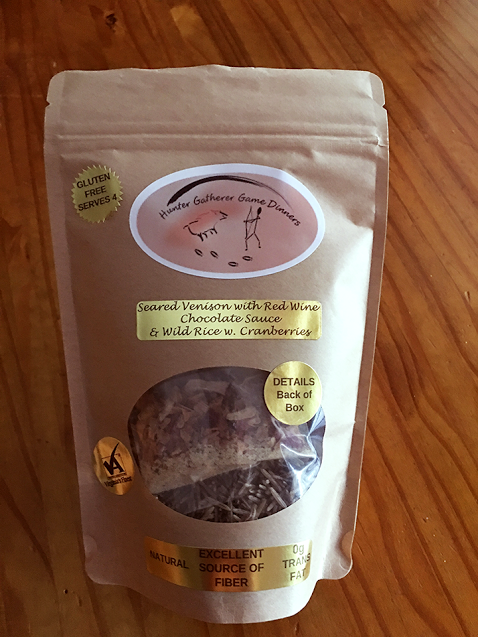
[Main course]
Seared Venison with Red Wine Chocolate Sauce
INGREDIENTS
- 12 oz. venison, elk, buffalo, filet mignon or rib eye steak (I prefer venison filet mignon)
- You’ll need to buy:
- 2 oz. pancetta or Italian bacon
- 1 – 8 oz. can low-sodium chicken broth
- 1 stick unsalted butter
- 1 cup Red Wine
- There are seasonings for the meat in individual packets labeled with numbers, as well as step-by-step instructions so it’s super easy to make!
[Side]
Wild Rice with Cranberries
- The wild rice and cranberries are also included in this kit, along with preparation instructions.
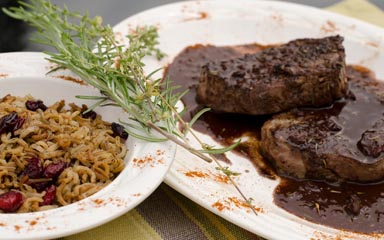
[Dessert]
Persimmon Bread
Most know that deer love to eat persimmons, but have you ever tried one? If you’ve ever tried one before they are ripe you probably think cooking anything with persimmons sounds like a bad idea, as they are awfully bitter. But once they turn ripe they are sweet and are great to use for pies, breads, cakes and cookies. Once they turn a purple/gray color and get soft they are ready for picking, usually after the first couple of frosts.
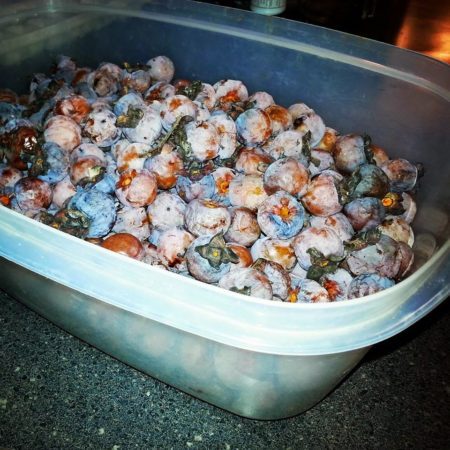
This recipe is my pumpkin bread recipe, but I swapped the 15 oz can pumpkin for 15 oz of persimmon pulp. To me, ripe persimmons taste very similar and have the same consistency as a pumpkin. To get the pulp you will want to smash the persimmons into a bowl through a cone shaped collander, this way you don’t get the skins or seeds in the pulp. We picked these and after smashing all of them through the collander we probably have about 4-5 cups of persimmon pulp. I put the pulp into zip-loc baggies, about 2 cups per baggie, and store them in the freezer until ready to use for cooking.
- 3 cups sugar
- 1 cup cooking oil
- 4 eggs
- 3 1/2 cups all purpose flour
- 2 tsp baking soda
- 1 1/2 tsp salt
- 1 tsp ground cinnamon
- 1 tsp ground nutmeg
- 2/3 cup water
- 15 oz persimmon pulp
- Preheat oven to 350 degrees. Grease 2 loaf pans.
- In an extra large mixing bowl, beat sugar and oil with electric mixer on medium speed. Add eggs & beat well; set sugar mixture aside
- In a large bowl, combine flour, baking soda, salt, cinnamon & nutmeg. Alternately add flour mixture & the water to sugar mixture, beating on low after each addition until just combined.
- Beat in the persimmon pulp.
- Spoon batter into pans
- Bake 55-65 minutes or until a toothpick comes out clean
- Cool in pan on wire rack for 10 minutes. Wrap & store overnight before slicing (The recipe calls for this, but I never do this. I absolutely love warm bread right out of the oven!)
By Andrea Haas
Andrea Haas is a Pro-Staffer from Missouri who enjoys hunting deer, turkeys, and upland birds. She is also the founder of the Huntress View, an organization formed to help strengthen the ever growing community of women hunters.
Taxidermy: Caring For Your Animal Pre-Mount
November 6th, 2016 by BTC Editor
As hunters and huntresses, we sometimes harvest that special animal that may be a first, a big buck, big fish, or beautifully plumed bird to get preserved and hang on the wall as a trophy. When you have that trophy in hand, what are the next steps to take to make sure it is properly cared for until it is safely in the hands of the taxidermist, and how do we care for the mounts when we get them back?
Growing up in a taxidermy family, I have seen everything from freezer burns and premature decay to faded and bug infested mounts. The care of an animal before and after it is mounted is key in keeping it beautiful for many, many years.
One of the first and very best things you can do before going afield is research taxidermists in your area and find one you are comfortable with. Most taxidermists will welcome you into their shops and showrooms that showcase their work. Talk to other hunters and find out what taxidermists they recommend. Do not go with the cheapest option because the mount will more than likely be poor quality. Bottom line, you’re going to get what you pay for.
Before the animal is mounted and before you are able to get it to the taxidermist, proper storage in the freezer is crucial to producing a good mount. Freezer burns are a common result of improper packing. On the other end, not getting the animal in the freezer soon enough can result in premature decay.
Mammal, bird and fish taxidermy are very different, so the way they are taken to the taxidermist will be different. When you collect any mammal, the first thing to know for field care is to avoid dragging the animal if at all possible. There are many tools/equipment out there to help you transport your animal. The second thing to know is to keep the animal cool until you can get it skinned or to the taxidermy shop no matter what kind of animal it is. Always consult with the taxidermist before skinning it. The quickest way to ruin a trophy is to skin it wrong. You may also want to wash off any excess blood or body fluids prior to freezing. The third thing is get it to the taxidermist as soon as possible. Carting a deer around is a bad idea, but a coyote or fox is an even worse idea. As nature rapidly takes it course, bacteria starts to grow as soon as the animal dies and the skin will start ‘turning green’ or rotting.
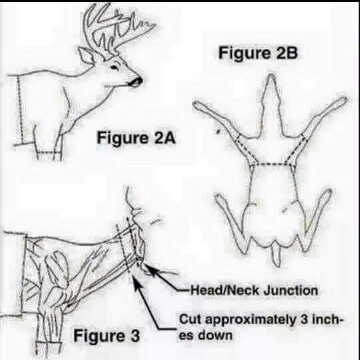
Birds will be put in the freezer exactly like they were shot. It’s not necessary to do any kind of skinning, so don’t take any of the meat or entrails out. The proper freezing position is to put the head on the chest of the bird and wrap it in a couple garbage bags and tightly seal it. Freezer Ziplock bags are also something good to use. Be careful to not bend or twist tail and wing feathers. One common misnomer is to put a bird in nylon hose and wrap it in newspaper. Many taxidermists cringe when a bird is brought to them inside a hose and even worse wrapped in newspaper. Newspaper will begin the process of dehydration and promote freezer burn, making the taxidermists job more difficult. Once you get a properly wrapped bird in the freezer, call your taxidermist and make arrangements to take it to them.

Fish have a completely different scenario than mammals and birds. The very first thing you should do when you pull the fish out of the water is take good quality, clear pictures of it. Take an overall profile picture and make sure to get any special markings or colors you want the finished mount to have. If you’re going to release the fish, measure it from the tip of the nose to the tip of the tail and the girth all around the body of the fish. If you are keeping the fish, do not skin or gut it and don’t put it on a stringer if you don’t absolutely have to. The best place to keep it is in a cooler or live well until it can be put in a freezer. When you’re ready to freeze it, get a wet t-shirt or towel and roll the fish in it. Wet towels or shirts are key in protecting the fish from freezer burn. Never use newspapers or paper towels. Put the wrapped fish into a trash bag and seal it tight. If you need to, double bag it. If it’s possible, freeze it on a flat board.
Try to have an idea of the position you want your animal mounted in. It will be that way forever. The taxidermist may be able to provide some ideas of positioning, but to avoid delays it is best to know what you want ahead of time.
When you see your mount for the first time, the memories come flooding back. You want it to look like that forever right? When placing your mount in your home, the best thing you can do is to keep it out of sunlight to prevent colors from fading and keep it dusted. Just like anything else sitting on the shelf, it will collect dust. Consult with your taxidermist about what is best to use for cleaning your particular mount. For fish and birds, a feather duster is most likely to be recommended along with never using any chemicals, as they will build up over time and cannot be removed. Dusting also applies to deer, however, some hair care type products are available.
Hopefully these tips will aid you in the process of preserving that special animal you were able to harvest, and to keep the memories of a hunt alive for years to come.
By Allison Stegmann
Allison is an avid waterfowl hunter from Iowa. She is currently a student at the University of Northern Iowa studying Leisure, Youth, and Human Services with an emphasis in Outdoor Recreation. Allison is also a member of of Huntress View, a team dedicated to strengthening the ever-growing community of women hunters.
What’s In Your Hunting Pack?
October 30th, 2016 by BTC Editor
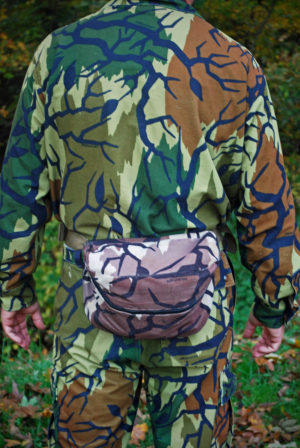
In two days, a couple buddies and I are heading to Pike County for a four-day bowhunting trip… No, not THAT Pike County, but it’s close. In fact, it’s right across the river from it. Both my pals are fairly novice bowhunters, and this is the first full season for one of them. Seeing as how I’ve been on several 10-day, DIY excursions to Colorado chasing my beloved wapiti, they’re leaning on me heavily to provide guidance as to what to bring. It’s actually not that uncommon a question from even veteran bowyers, as I see the “What’s In Your Bag?” query on the bowhunting forums quite often.
After well over a couple decades’ worth of bowhunting, with most of that time consisting of over 100 stand sits annually, I’ve definitely settled on a list of “must-haves” as well as items that have found their way into and out of my fanny pack. I’ll break down below exactly what I carry with me, and the use for each item.
- A small Ziploc bag (for weather protection) holding a good amount of toilet paper, plus hunting licenses. Also included in this bag are small zip ties for affixing the licenses to the deer’s back legs, a tube of chapstick (seems my lips are prone to drying out on windy days while on stand), and a handful of cherry cough drops (nothing worse than getting that tickle in your throat when you’re set up within 100 yards of that big buck’s bedding area!). I also put a nice lensatic compass in the bag, to keep the glass lens from getting scratched all up by the other items in my pack.
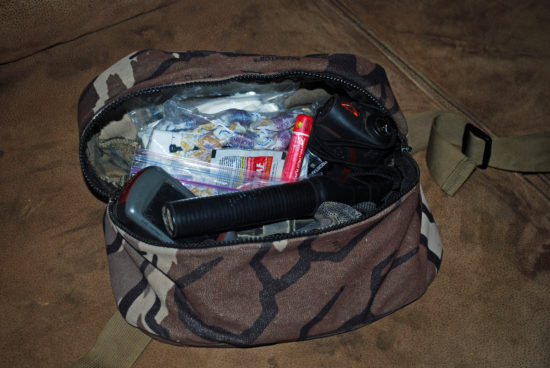
I’ll give you a tip about the toilet paper before moving on… I carry quite a bit of it with me, and obviously you probably realize one of its primary purposes. But I also lean on it just as heavily when tracking a deer at night by propane lantern. I tear off little half-squares and place every couple feet along the blood trail I’m unwinding… it’s remarkable how you can hold up your lantern and see those white squares trailing off into the blackness, and they’ll really help you get a “line” on the direction the deer’s traveling and where to look for next blood if you’re having difficulties. An added bonus is that when you’re done, you don’t have to go back and retrieve all of them — just let the next rain dissolve all of them for you.
- A mini-mag flashlight… the triple-battery version. I often end up in hairy places after dark I’ve never been through before, and I like to see what I’m trying to wade through – be it thorn bushes or a small creek. The version I like to carry just fits into my fanny pack from end to end, and utilizes three “AA” batteries.
- A headlamp. Sometimes, I’ll opt to turn my cap around backwards and slap on the headlamp. It’s especially helpful when I’m assembling my stand at the bottom of my tree after I get down in the pitch black, or when I’m gutting a deer after dark.
- A Leatherman multipurpose tool, the small kind. It contains a three-inch knife blade that I’ve used to gut over 50 deer, antelope and elk with. And on the off chance I need a pair of pliers, they’re included too.
- Limb saw… to trim shooting lanes with, and more importantly to cut off small branches on the tree I’m going up with my climber.
- My pull-up rope. I bought a commercial one with the plastic swiveling ends and hooks on it, cut those off and attached those to 30’ of parachute cord. Packs much tighter than the commercial one I bought.
- Rattle bag. I’ve got a very nice set of real rattling antlers that sound awesome, but they’re a pain to carry all the time. My rattle bag fits nicely inside my pack and is always there from the third week of October until December.
- Bleat can. I can’t attribute any single deer to coming in to the can call, but I’ll mix it into my rattling sequences any way; the hope is it’ll sound like the estrus doe that the two bucks are fighting over.
- True Talker grunt tube. This has accounted for more deer riding home with me than any other single piece of equipment.
- Ninety percent of the time, my shot opportunities are limited by heavy undergrowth and are 30 yards or less. Every once in a while though, I’ll sit a field edge where the rangefinder comes in handy.
- Diaphragm turkey call in a clear case. Archery deer tags come with two turkey tags included, and I won’t pass up an opportunity to call to a passing flock. I’ve got a wall-full of turkey fans above my desk that were all taken with my bow in deer season.
- Extra release. In case I leave my main one at the truck or it falls out of the tree for some reason.
- Four bow hooks. My bow goes on one above my left shoulder, and my fanny pack hangs from one around seat height on the same side of the tree. The other two are spares.
- A Kwikee Quiver caddy with my Octane quiver holder attached. I screw this into the left side of the tree, and affix my quiver upside-down so if I shoot and need to reload quickly, I simply reach behind me without looking and pull another arrow out.
- A hand-held Magellan GPS. This is a recently new addition to my pack, and one that I’ve come to value. I shoot a lot of deer just before dark as evening hunts comprise 98% of my trips afield (I’m just not a morning person). Usually, by the time I recover the deer and head back to my vehicle to get my game cart, it’s pitch black once I return to the scene of the crime. Having marked where my deer is laying via the GPS sure does make it a whole lot easier once everything looks completely different in the dark – and a whole lot easier to get out of the woods.
You could ask me any day of the year, and that’s what I’ll have in my fanny pack. It’s the main component of a system that I’ve fine-tuned for over 20 years of bowhunting, and it’s what enables me to grab my gear extremely quickly when I get home and be on my way to the woods in just a few minutes. I’m never scrambling around looking for this item or that; I simply know exactly where everything I need is.
Now, if it was only that easy to know where that big buck was…
Greg Staggs is the former back-page columnist for Inside Archery, and his writing regularly appears in such magazines as Outdoor Life and Petersen’s Bowhunting. Staggs loves introducing his two boys to all things outdoors, including fishing, trapping, canoeing and camping, and has been chasing turkeys and big game exclusively with archery equipment for over 20 years.
10 Pheasant Hunting Safety Tips
October 16th, 2016 by BTC Editor
10 Pheasant Hunting Safety Tips
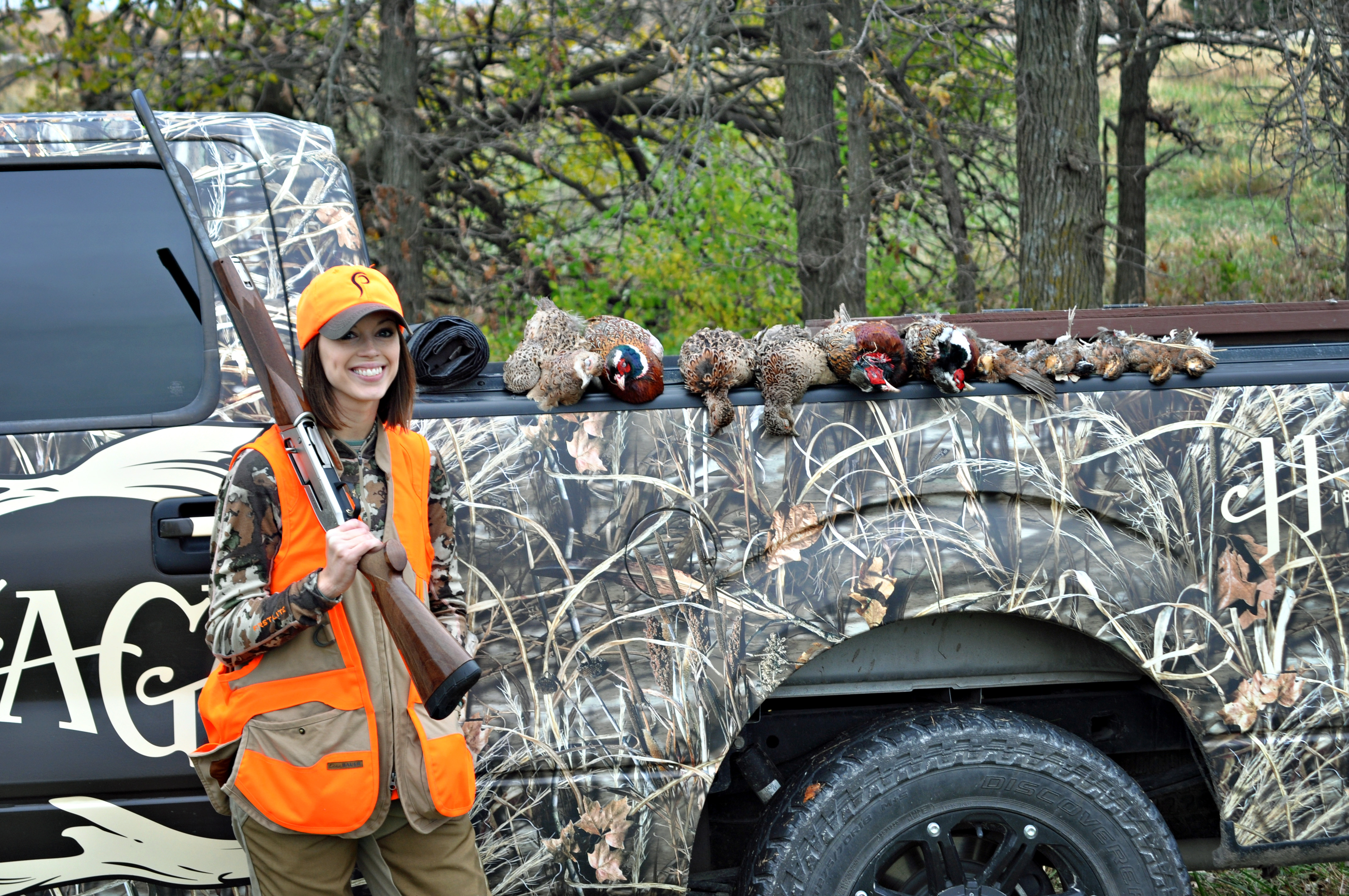
I’ve only been pheasant hunting for about 4 years now, but one thing that has been clear to me from my very first hunt is the importance of safety. It’s your responsibility to handle your firearm safely so you keep yourself, your hunting buddies, and the hunting dogs safe. After witnessing a couple of accidents on my hunts (luckily nothing serious), I feel it’s important to share a few safety tips.
- 1) Always point the muzzle in a safe direction.
- 2) Don’t rely on your shotgun’s safety feature alone to prevent an accident. Keep your safety on and finger off of the trigger until ready to shoot.
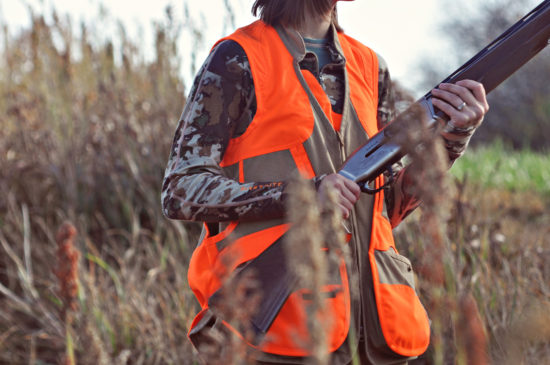
- 3) Start each hunt with a few safety reminders. It may seem monotonous after hunting for years, but it’s something that needs to be reinforced each hunt.
- 4) Know where your hunting partners and dogs are at all times. One of our hunting partners ended up getting shot in the arm one year because he was downhill from the group who was walking out a field and he failed to tell anybody. Luckily he was far enough away that it didn’t cause much damage, but it could have ended very badly.
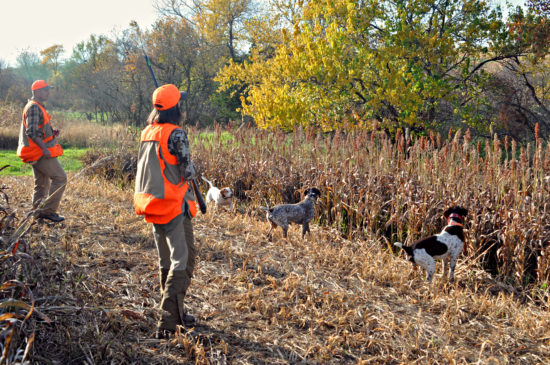
- 5) When walking out large fields make sure you and your hunting partners stay in an even line, paying attention not to get too far ahead or behind so no one is in the line of fire.
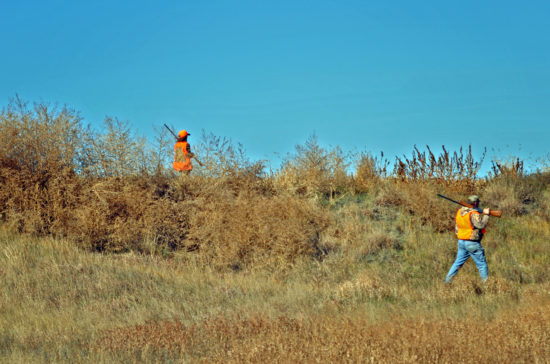
- 6) Make sure your shotgun barrel is free from obstruction. Have you ever been walking out a field and fall into a badger hole, smacking the end of your shotgun barrel into the ground? Well, I have a couple of times. My hunts could have taken a wrong turn after that had we not checked my barrel and cleaned the mud out.
- 7) Make sure you aim above the horizon and see sky before you pull the trigger. When a pheasant flushes the dogs will often jump up and try to catch it. It would be horrible to shoot a dog or a person, so always make sure you let the pheasant get up high enough before shooting. If you don’t have a clear shot, just pass.
- 8) Make sure you are putting the right size shell into your shotgun. For example, never put a 20 gauge shell into a 12 gauge shotgun.
- 9) Never climb/cross a fence with a loaded shotgun.
- 10) If your shotgun fails to fire, wait about 10 seconds, keeping it pointed in a safe direction and your finger off the trigger. Unload the gun and dispose of the ammo.
As with any hunt, safety when handling your firearm is the most important thing. Accidents are few and far between, but just remember that they can happen to anyone at any time. Remembering the above tips will make your pheasant season more safe and enjoyable for all involved.
By Andrea Haas
Andrea Haas is a Pro-Staffer from Missouri who enjoys hunting deer, turkeys, and upland birds. She is also the founder of the Huntress View, an organization formed to help strengthen the ever growing community of women hunters.
D.E.E.R. Project
October 9th, 2016 by BTC Editor
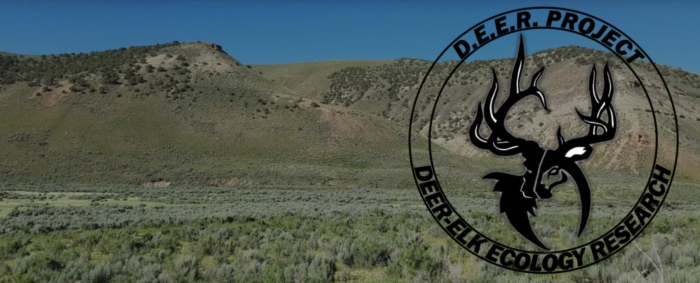
D.E.E.R. Project
By Matthew Hayes
Mule deer have a complex history throughout the western United States. In the days of the early settlers and pioneers, mule deer were relatively scarce; many trappers and explorers reported only occasional sightings of mule deer whereas other big game species were regularly observed. At the beginning of the 20th century, mule deer populations had been drastically reduced in number due largely to overharvest, market hunting, and overgrazing. Protections were put in place in the early to mid-1900s, eventually leading to ideas such as the North American Model of Wildlife Conservation, which was followed by a dramatic increase in mule deer populations. Mule deer populations peaked between the 1940s to the early 1960s throughout the western US.
Fast forward a few decades to the present day. With a lens to examine population fluctuations over the past 40+ years, a clear pattern has emerged. Populations, at least in Wyoming, appear to go through cyclical periods of increase followed by sharp declines. In reviewing literature and historical documents, concerns about mule deer populations tend to follow huge decreases in populations and when they subsequently rise, research and management become less important. Another point that seems clear in Wyoming is that although we have this see-saw in population numbers, there is a general declining trend since at least the 1970s. On average, Wyoming has seen a roughly 20% reduction in mule deer populations.
The population swings, and general decline, of mule deer since the 1970s has been difficult to understand. A variety of factors have been proposed to explain these declines, including: overharvest, harsh winters, habitat, drought, predation, disease and burgeoning elk populations. Managers have long noted that many areas that mule deer inhabit face different pressures and that populations are likely being driven by a variety of factors. All factors are not influencing populations in each portion of their range. This complication has meant that gaining a more complete understanding of reasons for fluctuations or stagnant growth in population numbers has been elusive. Without a solid understanding of the why and how associated with population fluctuations, it is incredibly difficult for targeted management to be beneficial.
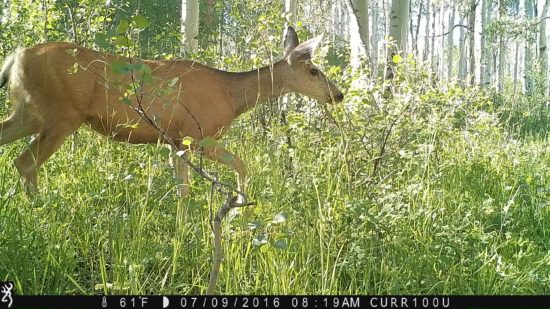
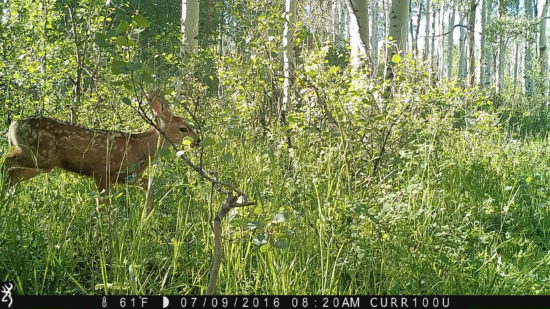
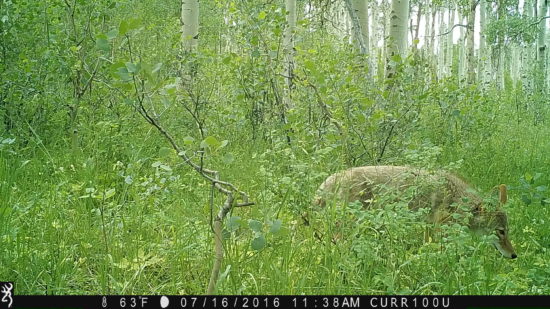
Researchers and managers have made great strides to better understand mule deer ecology and factors relating to their survival and reproduction. In the early 2000’s Global Positioning Systems (GPS) became small enough to fit onto a collar sized for ungulates. Since then, studies have been conducted examining migration and use of the landscape in summer and winter. The effects of drought and shifting precipitation regimes have been investigated as well as determining when, where and how animals are dying. Wyoming has been at the forefront of this research and has helped to better understand the ecology and management of mule deer. A key ecological process that has remained poorly understood are the interactions between mule deer and elk (though some work has been done at the Starkey Experimental Forest).

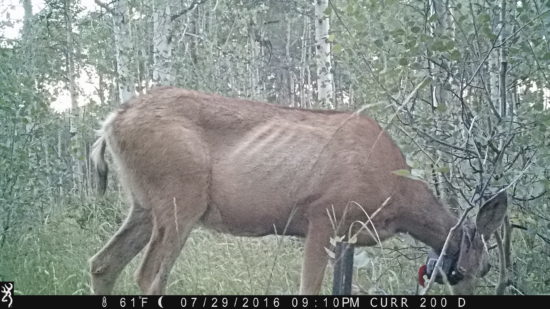
Mule Deer with GPS tracking collar.
Both mule deer and elk are highly cherished big game species. Wyoming and her residents rely on these animals for hunting, tourism and as a part of our cultural heritage. Nevertheless, at the same time those mule deer populations have generally declined, elk populations have increased dramatically across the same geographical range. Managers and researchers have long wondered if mule deer and elk could be competing for space and resources but, until recently, the ability to study these interactions was almost impossible. Potential for interactions between these 2, highly valued species to affect one another’s abundance has been a bit of a conundrum for decades, probably given the challenges associated with addressing such a complex question. The Deer-Elk Ecology Research Project (DEER) was ultimately incepted out the need to unravel the head-scratching complexities of poor performing mule deer populations, while a similar big game animal continues to grow in the same country.
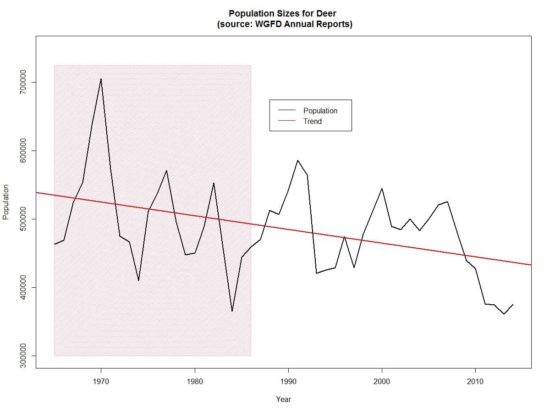
Population sizes for Deer

Population sizes for Elk
The DEER Project, located in the Greater Little Mountain Area of southwestern Wyoming, aims to increase our understanding of both mule deer and elk. This project is examining parturition timing and location of mule deer, mortality and recruitment of fawns, nutritional condition of adult female mule deer, summer diet overlap between elk and mule deer, space use, recruitment of male mule deer, survival, migration, and dispersal. We also are implicitly examining winter severity, habitat use, precipitation patterns, predation and disease. One of the greatest strengths of this work is the rigorous monitoring of both mule deer and elk in the same system. Many studies prior have examined one species or the other with inference to supposed interactions, but the DEER project will be able to analyze these interactions at a much finer scale. Another added benefit of this project is that it occurs in a high-desert system—an ecosystem ubiquitous throughout Wyoming but less studied compared to high-elevation systems. Far from being a one-off or unique system, the results from this work will be applicable to mule deer and elk throughout their shared range.


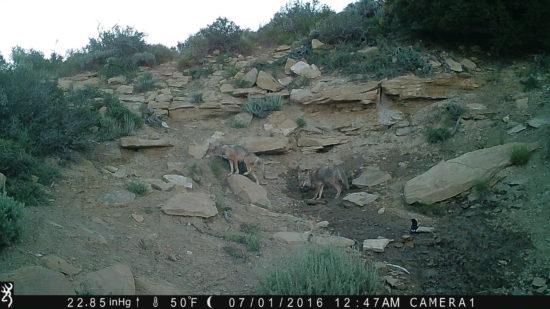
Future articles will focus on updates from the DEER project. You can follow along with the project, donate and subscribe for updates at www.deerproject.org.
The Western Association of Fish and Wildlife Agencies (WAFWA) has explored the issue of mule deer decline in depth and has published a very approachable book on the topic; you can check out the website at www.wafwa.org and navigate to the Mule Deer Working Group for more information.


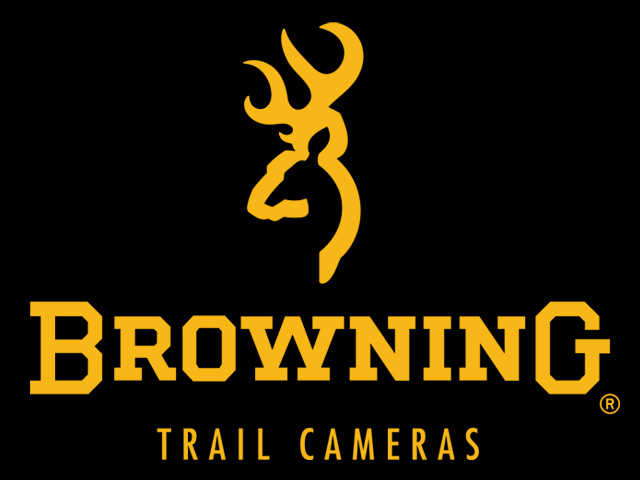
FOR MORE INFORMATION: 
UNIVERSITY OF WYOMING
Kevin Monteith 307-766-2322 kevin.monteith@uwyo.edu
Matthew Hayes 307-766-5417 mhayes1@uwyo.edu
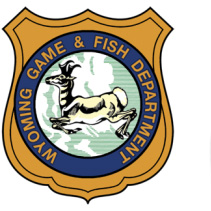
WYOMING GAME & FISH DEPARTMENT
Patrick Burke 307-875-3223 patrick.burke@wyo.gov
Mark Zornes 307-875-3223 mark.zornes@wyo.gov
Kevin Spence 307-875-3223 kevin.spence@wyo.gov
Early Season Bowhunting Tactics
October 2nd, 2016 by BTC Editor
By Greg Staggs
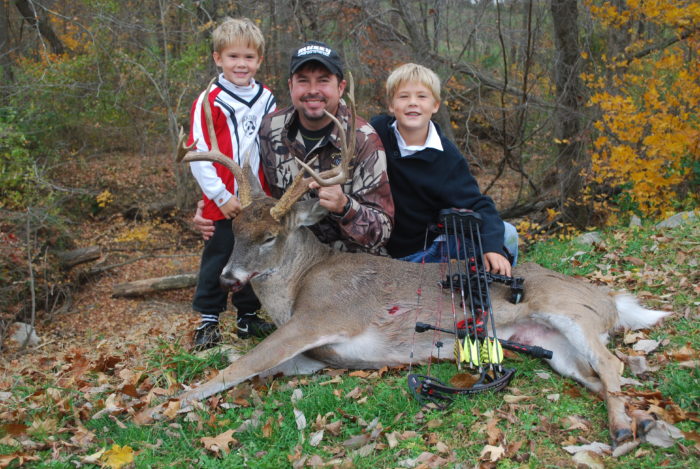
I turned and idled gently up the drive, palms getting clammy even as my breathing became shallower. Easing my truck to a stop, I quietly reached down and turned off the ignition and allowed the silence to envelope me. Going over my planned routine seemed to settle me a bit, and I took one last deep breath and opened the door. I had been thinking about this moment for weeks and it was finally here. Sliding off my seat, I walked as confidently as I could up to the door, knocked and asked if my date was ready.
First dates in high school probably provided as much nervous anticipation as anything I would experience for the first part of my life… until I started bowhunting. Today, I still idle gently into my parking spot. My palms may not be as clammy, but my senses are definitely heightened as adrenaline courses through my veins, thinking about the possibilities, the “what-ifs”… And my planned routine? It’s down to a science.
Chasing whitetails across the Midwest in September and October is truly a love of my life these days. Here are three things that have become a part of my routine that’s led to years of punched tags and filled freezers early in the season.
- Scout with a light footprint. Amazingly enough, I don’t spend a lot of time in the woods in the summer. Most of my whitetail hunting is done on public land with miles of corn and soybeans backing up to the woods. I’ve spent many a night tucked into a fence row on the opposite side of a field glassing to identify which corners the deer are using to enter the fields.
- Stay away as much as possible. If I can place a trail camera there on one visit and retrieve a card from it a month later, it’s harder for the deer to pattern me but I’m gaining valuable reconnaissance the whole time I wasn’t there. Taking it a step further, even my trail-camera placement leaves little presence. Ever walked into the woods and noticed a camera staring at you at eye-level? It can be obtrusive and stick out like a sore thumb. I’ve had deer think the same thing; I can tell by their reactions I’ve captured. A lot of times these days – especially on public land – I’ll take a lightweight climber with me and angle my camera down from twelve feet or so. It also keeps honest people honest, as my Dad used to say.
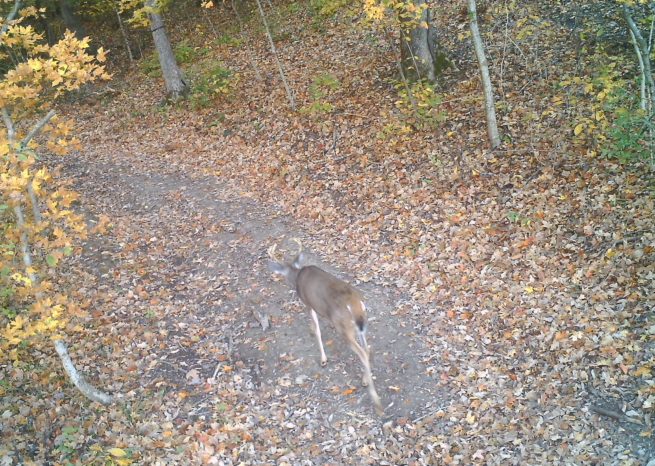
- Hunt with a light footprint. The first couple months of archery seasons in the Midwest can be downright hot. Deer don’t like to travel any farther than they have to, which means they’ll often bed less than 100 yards inside the woodline. If you plan to dive deeper in the woods this time of year, plan on bumping some deer. I’d rather sneak in and out of the edge a few times than blunder up once and alert every deer in the woods to your presence – especially a full month ahead of that magical November time-frame.
Greg Staggs is the former back-page columnist for Inside Archery, and his writing regularly appears in such magazines as Outdoor Life and Petersen’s Bowhunting. Staggs loves introducing his two boys to all things outdoors, including fishing, trapping, canoeing and camping, and has been chasing turkeys and big game exclusively with archery equipment for over 20 years.
Archery Tips with Levi Morgan
September 18th, 2016 by BTC Editor
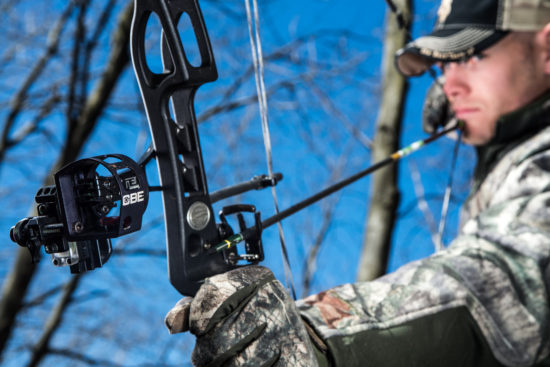
BTC: What steps do you go through mentally when you draw back on an animal to ensure your form is right and to help calm your nerves?
Levi: You know it’s funny, I don’t think. I think it’s all in practice when you do that because everybody, including myself, when you get out there in the woods and that buck of a lifetime steps out, no matter how hard I try or how much I tell myself, “Hey, I’m going to really slow down next time and I’m going to think about what I’m doing”, I look back and go “Man, that was a blur. You know, I don’t even remember that.” I don’t remember what I did, I don’t remember why I did it, so I think It’s so important to not just get your bow and go out and shoot just once every couple of weeks or get it & take it out 3 weeks before season, because you have to create that muscle memory and teach yourself to slow down and practice.
One thing I do is hunt with a caliper release. When a big deer would come out, I would draw back and get in such a hurry that when my pin got there I would just press the release off. I wasn’t really freaking out or anything, but I was rushing the shot every time. I was afraid the deer was going to run or it was going to see me, I was just nervous. So when I need to slow myself down, I started hunting with what’s called a back-tension release, or a hinge release, which forces you to slow down. You can’t shoot it fast or it’s an epic fail, so it forced me to slow down.
I really feel like it’s easy to say, I’m going to think about all these different steps when a big buck comes out. But the truth of the matter is, I really feel like people are going to do what comes naturally to them, which is why I think it’s so important beforehand to be prepared and have your equipment fit you perfect. Really get to know it and shoot it all the time because when you get nervous and everything goes blank, you’re going to revert back to what you do naturally with that bow and the way you practice with it. I really think that’s the best way to be prepared for the moment of truth.
Also, when I’m sitting in the stand or when I’m out hunting sheep, I imagine opportunities happening. For instance, if a buck comes down that trail, where am I going to shoot him at? Where am I going to stop him at? How is he going to be angled if he’s on that trail or if he walks out into the food plot? I try to imagine every scenario that could happen to me while I’m sitting there or while I’m hiking so when it does happen I’ve already kind of played it out in my mind that I’m going to stop him here and he’s going to be perfectly broadside or a little quartered away.
Obviously in hunting, you never know what’s going to happen, but that has helped me before. Nothing is as important as just being really prepared.
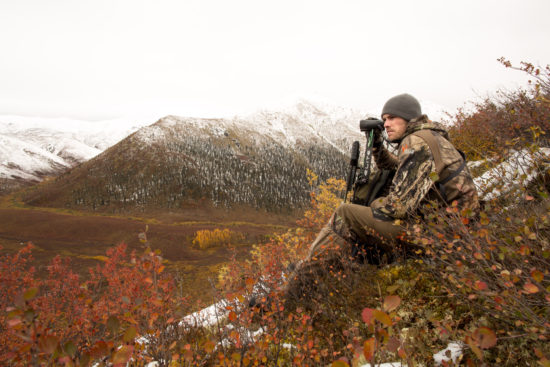
BTC: A lot of archers and bow hunters struggle with target panic. What advice do you have on how to overcome this?
Levi: Target panic is probably the most common thing in archery. I think almost everybody has been through it at one time or another if they’ve shot a bow long enough. There are so many causes of it and because of that there are a lot of cures. I think some of the main causes of target panic are too heavy poundage, too long of a draw length, or not having equipment that fits you. Also things like your peep being too small and things in your sights that are making you too uncomfortable, for example your pins being too small to see, the target being blurry…All of those things can cause it.
Another major cause is holding your breath when you shoot. I’ve talked to professional fighters and doctors about that. When you hold your breath the first muscle that starts to break down is your eyes. That’s a huge cause of target panic so that’s why it’s so important to keep breathing. I’ve seen people pull back, hold their breath and aim too long and just feeling like they HAVE to shoot now. That’s really all that target panic is, no matter what the cause, is when the pin hits the target they feel like they have to shoot now.
I think the best cure for target panic is to stand in your yard, pull back and aim at the target with your arrow loaded and finger on the release. Put your pin in the middle and leave it there but don’t shoot the arrow. When your pin starts to go, let it down. Take a few seconds to regroup, then pull back and aim at the target and let down again without shooting. Do that over and over for however long you normally practice for about a week or so. All that’s doing is letting your mind know, “It’s ok for my pin to sit there. I’m in control. I don’t have to fire this shot”. Also what it’s going to do, is you’re going to aim at the middle longer and longer, allowing you to build up that confidence and stamina to keep your pin in the middle longer to let you execute that perfect shot.
I think that’s one of the best drills there is. It lets you just focus on aiming, relaxes your mind and lets yourself know that it’s ok to aim at the target and not fire that arrow as soon as the pin gets in the middle.
BTC: What are some of the bad habits you’ve had as an archer and what helped you the most in overcoming them?
Levi: I think my worst habit, as a hunter and shooter, is when I get in a hurry. I go out and practice just to be practicing. Practicing numb is what I call it. I think when you stop trying to get better, you’re going backwards. For me, I think it’s really important to count on myself, even in practice. I don’t go out and shoot at 30 or 40 yards at the same dot every day. I try to challenge myself, whether that’s moving back further distances or trying to hit so many arrows in a row on a certain dot. Whatever games you can play to make it fun for you, that makes you challenge yourself and keep trying to get better every single time you practice and not get complacent. What should be 4 inch groups at 40 yards may be plenty good to go hunting, but it’s not the best that you can do. I think a lot of people say, “Well that’s good enough”. I’ve heard it so many times. It’s easy to do that when you’re shooting good enough but it’s important I think, for me especially, to keep challenging myself and keep trying to shoot better groups at further distances and really keep it fun and interesting during practice.
BTC: You’re going to Alaska soon to hunt sheep as part of your quest to complete the Super Slam with your bow. How far are you from completing the Super Slam?
Levi: There’s 29 animals in the Super Slam and I have killed 17 of the 29 with a bow, so I’ve got 12 left.
BTC: Which animal has been your favorite to hunt so far?
Levi: Probably my Dall Sheep in the Yukon. It was the hardest. I guess it felt the best when it was over. It was the most satisfying when the hunt was done because of how hard we had to work. We spent 14 days on horseback (The episode just aired the evening we talked on the Sportsmen Channel).
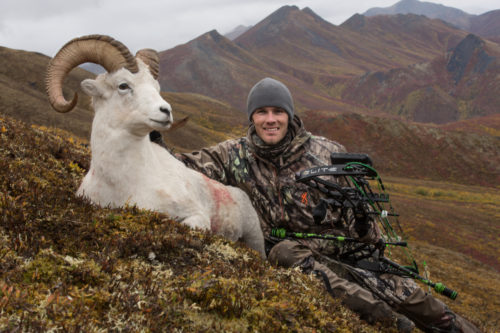
BTC: Do you have any advice for others who are wanting to complete the Super Slam?
Levi: Yes. Go to their website, www.superslam.org. The first thing I would say to do is to become a member of Super Slam because they give away hunts every month, and these adventure type of hunts are not cheap or easy to go about getting.
Also, do a lot of research. These are not your normal types of hunts. I grew up a whitetail guy, hunting whitetail in the Midwest. When I started doing these hunts, going to the Arctic, Mexico, the Yukon and all over the world, it was just a wakeup call on what gear I needed and how little I actually knew about my equipment. I think it really teaches you a lot when you go to those places and you’re riding on a horse for 14 days. You never know when something can go wrong, so get to know your equipment really well, do your research on what you need to take, and don’t cut corners on your gear. The weather is so uncontrollable out there on these adventure hunts.
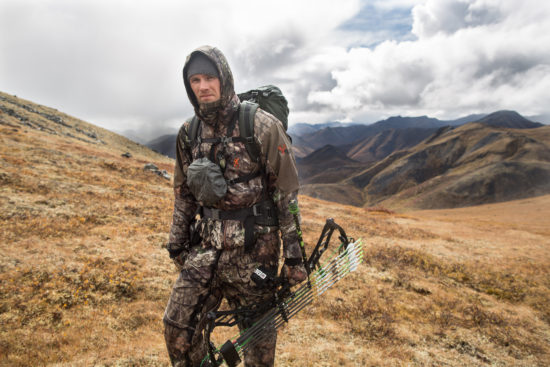
Dove Hunting Basics
September 17th, 2016 by BTC Editor

There has always been a lot of excitement surrounding the beginning of fall. Cooler weather, hoodies and bonfires are just a few things we start to hear about around the first of September. But to most hunters, September means dove hunting and marks the beginning of the fall hunting seasons!
For most states, dove season is now underway. If you are thinking about bird hunting for the first time this year, I highly suggest giving dove hunting a try. It’s one of the simplest types of bird hunting to get into, as far as obtaining the proper licenses and the cost of hunting equipment. Plus, the hunting atmosphere is generally pretty carefree and relaxed, which I find is much needed compared to how serious whitetail hunting can become.
Here are a few dove hunting basics to keep in mind when preparing for dove season.
Practice
While I do feel dove hunting is one of the easiest and cheapest types of bird hunting to get into, I think doves are one of the harder game birds to hit. Not only are they small and fast, they zigzag through the sky making for a fun, but challenging hunt.
To prepare for my first dove season I practiced shooting skeet in my backyard prior to the season opener. I was new to bird hunting altogether at that time, so that helped me get more comfortable with handling a shotgun. If you have a sporting clay course near you, that is probably one of the best ways to prepare for shooting live birds since the targets are thrown at varying angles and speeds, simulating a more real-world hunting experience.
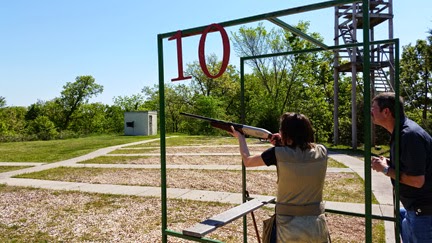
Shooting on a sporting clay course
Licenses and Equipment
For dove hunting you will need a hunting license and Migratory Bird permit, which are both relatively cheap. Always double check with your state conservation department to make sure you have the proper permits.
Besides your hunting permits, you will also need a shotgun and shotgun shells. I prefer my auto-loading Browning Maxus shotgun. Again, make sure you check the regulations with your state conservation department. Most states require you to have a plug in your shotgun that won’t allow you to have more than 3 shells in at at time.
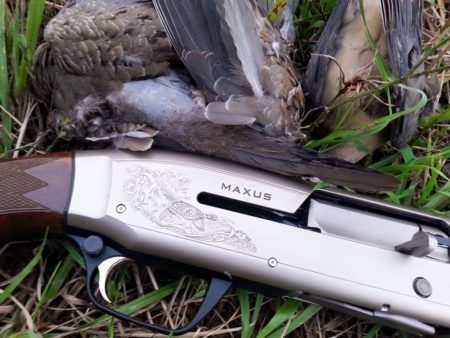
A good shotshell size for dove hunting is a 1 or 1-1/8 ounce load of 7 1/2’s, like these shells from Browning Ammo. It really only takes a few pellets to down a dove so you shouldn’t need to go larger than a 7 ½ or 8. Like it or not, with dove hunting you are going to miss sometimes, so always bring more ammo than you think you will need!
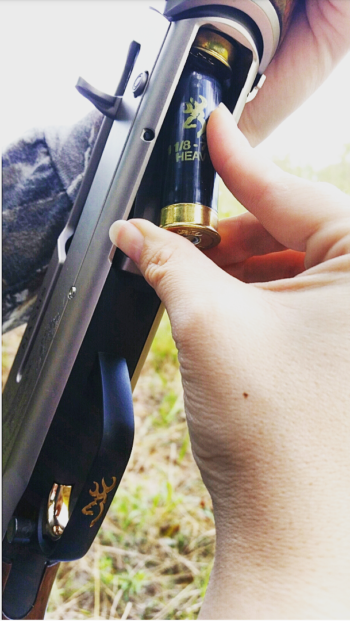
You may want to purchase a small stool or seat to sit on while out hunting. When the doves are flying good, you could be out hunting for hours, so you may as well make yourself comfortable and at home! This Dove Shooter Stool from AlpsOutdoorz is a good option. It has a strap that makes it easy to carry to and from the field. There is a cooler underneath the seat so you can bring lunch and keep your drinks cool. It could also double as a way to carry your shells or your doves. The front pockets are great for holding boxes of shotgun shells, or holding a few decoys!
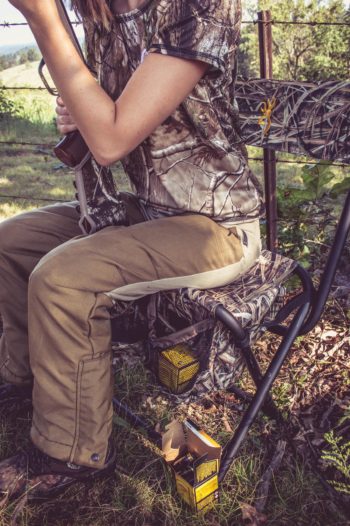
Dove Shooter Stool and Browning Ammo
Decoys
You don’t have to have decoys but they often help bring doves in for a closer shot when they would stay out of shooting range otherwise. Placing a few decoys on open ground, as well as a few on nearby tree branches or a fence row is generally a good setup. When placing decoys on tree limbs, the higher the better. Doves tend to fly into the wind, so you’ll want to place your decoys facing that way.
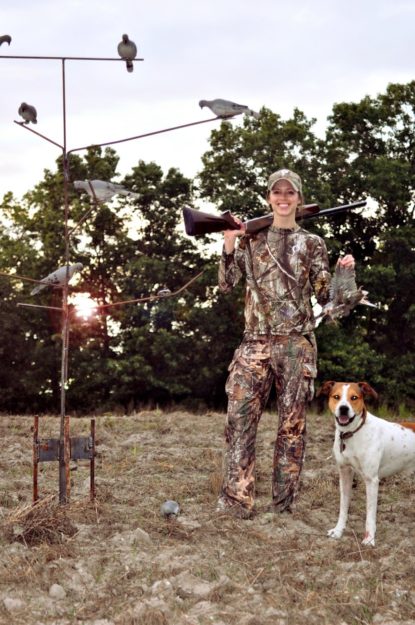
Concealment
Doves have good eyesight so you will want to wear camo that blends in with your surroundings. Where you and other hunters set up is also important. I like to set up along tree-lined edges and will often make a blind out of the surrounding brush or cedar tree limbs for added concealment. It’s also a good idea for your shotgun to be camouflaged, but is not always necessary.
Lead the Bird
What works for me is aiming ahead of the dove, squeezing the trigger and swinging through the shot. You may be surprised at how far you have to lead these speedy little birds, so if you keep missing I’d try leading the dove even more.
I admit that I missed every single dove I shot at during my first season. By the time my second season rolled around and I was able to connect on some birds, I learned what I had been doing wrong. Instead of leading the birds and swinging through the shot, I got anxious and was just flinging my shotgun up and forcing a bad shot. Once I actually hit a bird, I got a good feel for what I was doing right and it was much easier from there on out.
Locations
There are a few different places that are good for hunting doves. If you can find a location where there are food sources, watering holes, and plenty of trees for a good roosting spot you’ll be off to a good start. One other thing to keep in mind is doves need grit to help digest the different types of seeds they eat. The grit can be found on gravel roads or any location where sand and dirt may be, so if you can hunt field edges bordered by gravel roads you should be in a great spot.
Typically, doves will be located around the watering holes just after dawn and then as soon as they return to their roost at around dusk. In the daytime you might find them sitting on power lines near the gravel roads for a few hours before they return to their afternoon feeding spots.
Whether you have been bird hunting for years or are just getting started, dove hunting is a great way to sharpen your wingshooting skills. It’s also a good way to introduce your children to hunting and allows them to get in more shooting time than hunting deer and other big game. Plus, there’s no better way to ring in the fall hunting seasons than a good dove shoot!
Andrea Haas
Andrea Haas is a Pro-Staffer from Missouri who enjoys turkey hunting, deer hunting and bowhunting. She is also the founder of the Huntress View, an organization formed to help strengthen the ever growing community of women hunters.
Jason Bosaw of Whitetail Freaks – 9/11 Interview
September 11th, 2016 by BTC Editor

BTC: Do you recall where were you and what you were doing on 9/11 when you heard about the terrorist attack? What type of impact did those events have on you as you watched them unfold?
JASON: Yes, I remember exactly where I was and what I was doing. I was working on the grain dryer at the farm. I was just very surprised that something of that magnitude could happen on American soil.
BTC: We understand that you are very committed to serving your community as firefighter. How challenging is it to manage both your farming and your hunting when you could get a call to respond to a call at virtually any given moment?
JASON: I am very committed to my job and my service as a firefighter, as well as to hunting. I am on call virtually 24 hours a day but my job and the firefighting come first. Balancing the two is sometimes difficult, but my willingness to help someone or their property comes to the forefront.

BTC: In your work with the Fire Department you have probably learned to stay calm and focused high stress situations. Has this helped you out at all in the moment of truth to keep from getting buck fever?
JASON: No matter how calm I may be able to stay at the response scene, it is nothing like when a big buck walks out in front of me. My heart still wants to beat out of my chest and my adrenaline level is sky high. I don’t think I will ever be able to contain that. They are two totally different scenarios.
Jason is one of the original Whitetail Freaks and counts his family and serving his community among his passions outside of his pursuit for the next great whitetail he encounters…
Ken Haas of Whitetail Freaks – 9/11 Interview
September 11th, 2016 by BTC Editor
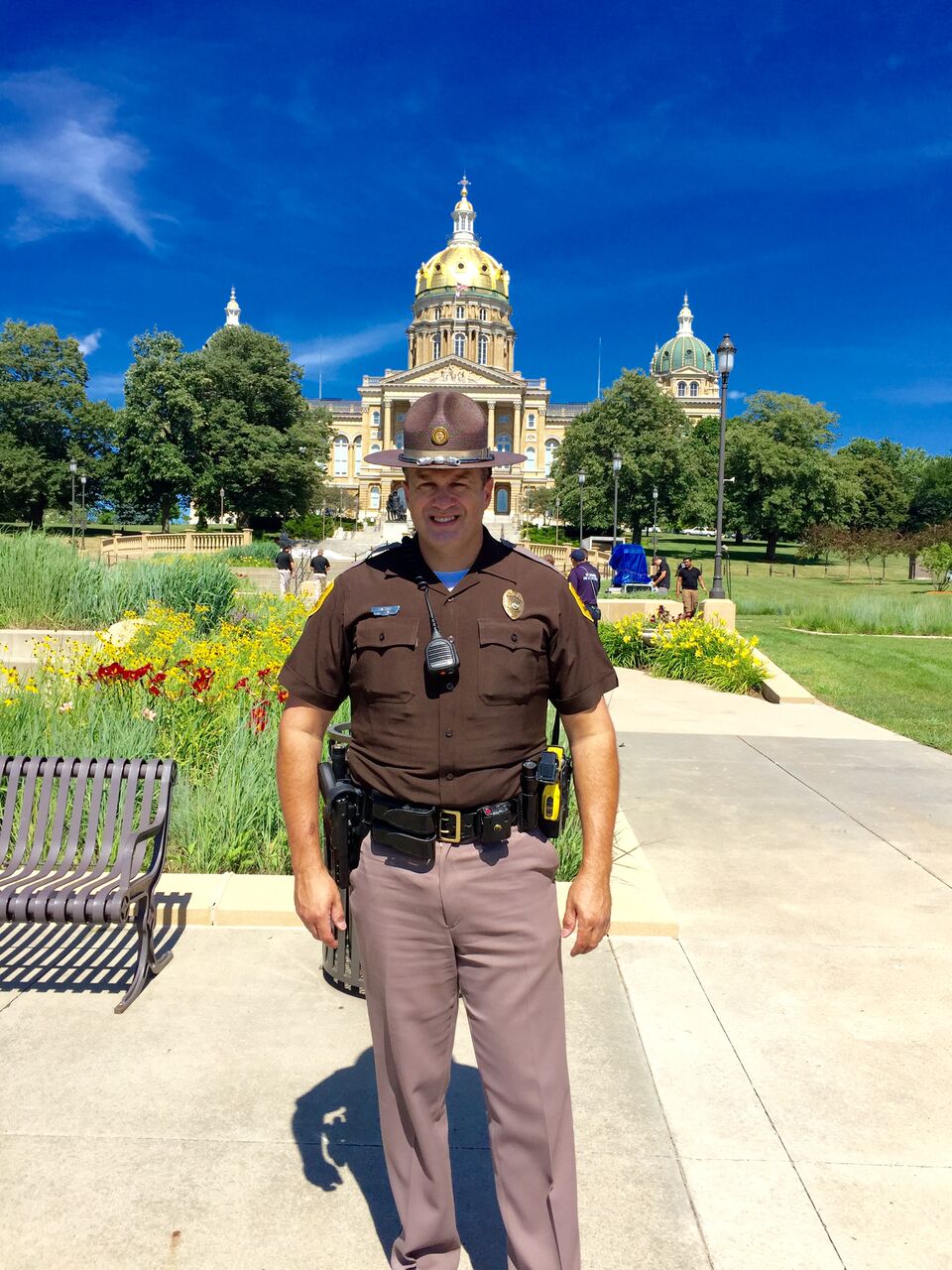
BTC: Do you recall where were you and what you were doing on 9/11 when you heard about the terrorist attack? What type of impact did those events have on you as you watched them unfold?
KEN: I was sitting in a grocery store in Council Bluffs, Iowa eating breakfast with two other Troopers while the news was on. We all watched in utter disbelief as the second plane hit the tower. All of us there were prior military and we all had the same gut wrenching feeling that we were under attack and felt very helpless watching the entire event unfold. I remember that day being very quiet and the airways going quiet as all air traffic had been grounded. Living equal distance from Offut Air Force Base and Omaha Eply Airfield it was eerily quiet. It was a huge surprise to see a plane I knew well fly by, that being Airforce one descending into Offut Airforce Base, which was no doubt bringing the President to the center of the country for safety.
As our soldiers continue to fight overseas, it is our job as Peace Officers to protect our country’s border to border against foreign and domestic terrorists. Extremist groups are a constant threat and the uniformed officer, sometimes referred to as “The Thin Blue Line”, are without a doubt this country’s greatest assets when preventing, disrupting and deterring future acts of violence and terrorism.
Few people know that terrorism is funded in part by the sale of drugs. The exploitation of the United States and its unfortunate appetite for elicit and illegal drugs is problematic when we spend billions of dollars on heroin that has been imported from overseas. I mention heroin first because of the horrible impact it has on our people, but I do not disregard the impact of the other drugs that are imported as well. As you start to see the larger picture of what is happening, you will understand that the facts of our purchasing these illicit drugs is devastating. That same money used from the sale of drugs will then go back into the pockets of terrorist organizations, allowing them to continue to fund their attacks on the United States and the rest of the world.
As with anybody that watched the unfortunate events unfold on September 11th, that day will never be forgotten. The loss of life, the bravery of the firefighters, the police and other EMS personnel, their memories will not be forgotten. It has been my experience that no matter how bad the tragedy, there is always something to be gained from it. In this case, understanding what funds terrorism and that the profit has cost the world thousands of lives lost unnecessarily, has fueled my motivation and the motivation of many others. The world’s worst criminals are the most vulnerable while they are in transit. By intercepting them we are able to make the biggest impact where we can.

Ken and his significant other, Malissa Driver. She’s a flight nurse and they are a family committed to public service.
There are many other stories like mine and my arrest of the terrorist suspect (see newspaper article below) that never see the light of day for security reasons, but rest assured uniformed and plain clothed officers are out every day doing their best to ensure that these major criminals do not travel freely to commit acts of violence throughout the country. I also take great pride in educating police officers from every type of policing agency across the country in criminal and terrorist apprehension training. I have instructed for more than 10 years in the state of Iowa, educating our officers and working for a private program called Desert Snow. I have traveled to almost all 50 states and shared what I have learned with thousands. I also take great pride in hearing about the success stories from the officers following the training.
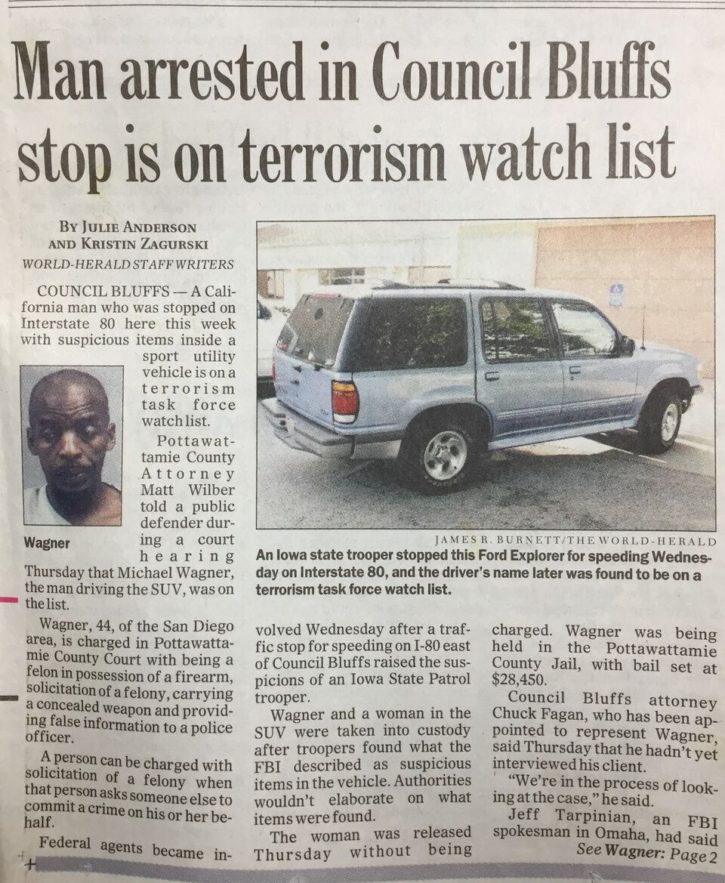
A newspaper article about a terrorist suspect Ken arrested
In 2011 in Glendale, Arizona I was given the distinct honor as being chosen as the United States 2010 and 2011 Bob Thompson Criminal Interdiction Officer of the Year by the United States Department of Transportation, the United States Department of Justice, the Drug Enforcement Administration, the Drug Interdiction Assistance Program, the El Paso Intelligence Center, and the former recipients of this prestigious award. I have very humbly received many awards in my career, but all of them ill in comparison to sharing and continuing to share what I have learned to educate new officers in the same principles for understanding and recognizing when criminal activity is afoot. That impact, no matter how significant, will change the course of someone’s life in a positive way.
Most importantly, I hope people understand that the Peace Officers of this country cannot do the job without the support of its citizens. As I travel and teach officers across the country, the sentiment from those officers and their communities that they serve is the same. The officers are being overwhelmed with gratitude from the good citizens of this country who didn’t understand that this is not just a Peace Officers fight, but this is a fight that includes everyone in our nation. We who serve without a doubt need the support of our communities and the willingness of those people to share information with us when they see things that are not right. I believe it is this cooperation that will continue to keep our country and its people safe. And those that continue to help law enforcement have my unwavering gratitude and appreciation for their continued help and their dedication to the protection of our communities. For those that have gone out of their way, and for everyone that has taken the time and thanked a Peace Officer, fire fighter, or EMS personnel, I thank you!!!! You, are the people that I am talking about.
BTC: What do you feel is the most rewarding about your job as a state trooper?
KEN: The most rewarding part of my job is tough. It has many facets that stretch out in many directions. Being a first responder and saving lives is huge. So is protecting the innocent from crime and the relentless pursuit of major criminals on our nation’s roads. Few people consider the fact that all crime is, at some point, in transit: the people perpetrating the crime, the proceeds of the crime, the tools to facilitate the crime, or evidence of a crime committed.
BTC: What skill sets learned from your job and training have helped you the most as a hunter?
KEN: So you might ask yourself, “What does this have to do with me hunting, and how do I apply what I’ve learned from such a tumultuous career?” It’s simple. It’s the desire to pursue something, in this case a whitetail deer, and becoming a student of the sport. Many people will refer to me as an expert in my field, both as a Peace Officer and as a hunter. Although it is very humbling, I see myself as a student who is always looking for new ways, a better understanding, and never taking for granted the information that is shared.
One instance I’ll share with you happened last year while hunting. As I was sitting in the blind and watching a buck chasing a doe in and out of cover, I watched intently as I always do and enjoyed watching the doe try to elude the buck. Soon as the buck lost sight of the doe and he could no longer see her he employed a tactic that was not only smart, but something that I had never seen happen before, or at least understood its purpose. The whitetail buck started to stomp his foot and blow in the same alarming mode as if he was to have spotted or smelled some type of danger. I immediately suspected that he had caught our wind and could possibly smell us. So I checked the wind direction only to be reassured that it was correct and the chances of that buck smelling us was nonexistent. That buck taught me that he would employ the same tactic that he would use to alarm deer of danger to get the doe to run from heavy cover where she was hiding so he could continue to pursue her. This was the first time I had ever seen this activity and understood what was happening.
At the end of the evening I immediately called Don Kisky to talk to him about what I had seen and ask him what his opinion was and what he thought about the encounter. After a short discussion, Don had told me that he had just seen the same behavior this year. He had never seen it before but had the same concern I did, that the deer actually had smelled or seen something that made the deer alarmed. We both enjoyed a good laugh as I stated to Don, “I might have taught Don Kisky something”. And knowing Don Kisky, that’s next to impossible when it comes to hunting whitetail deer. Really we just shared an observation that we both learned from.
So how does my career pertain to whitetail deer hunting you might ask? Simple. It’s the same perseverance, it’s the same willingness to learn and continue to learn, and a never quit attitude that keeps me going. It’s also tradition, a strong sense of brotherhood, and it’s something I love to share with my children. My children understand the “circle of life” and the life lessons that we have had the privilege to enjoy together. They understand that hunting isn’t a right, it’s a privilege, one that we enjoy along with many other privileges. All of those privileges came at a very high cost and I feel very humbled and privileged to be able to share with many two of my greatest passions. To quote Lee Greenwood, “And I won’t forget the men who died that gave that right to me”.
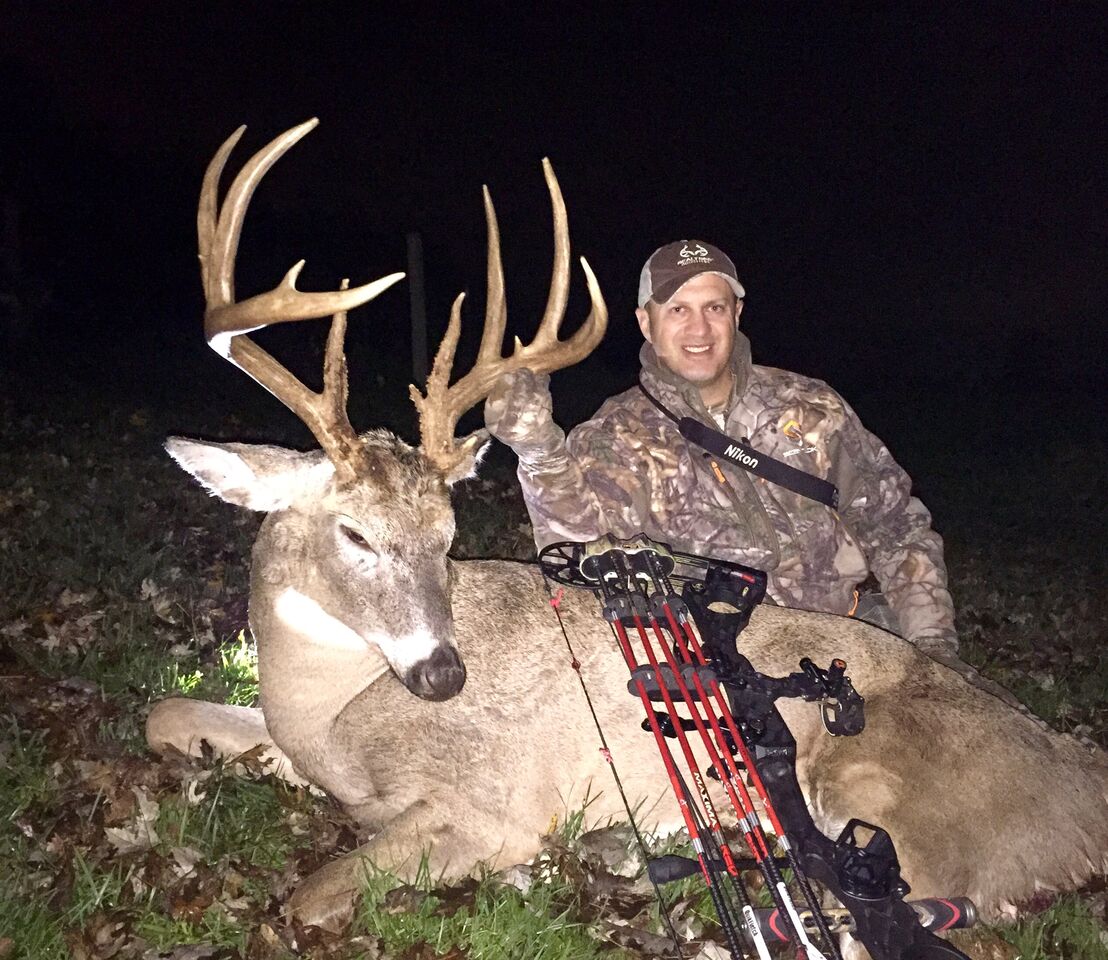
One of Ken’s 2015 bucks
Trooper Kenneth W. Haas #345 Iowa State Patrol
Ken Haas is a native of Omaha Nebraska and lifelong resident of the region. Upon graduating from Millard South High School in 1990 Ken joined the Army National Guard, honorably serving for six years.
Ken received a Bachelor of Science in Criminal Justice from the University of Nebraska-Lincoln in 1996. While working on his B.S. degree, Ken worked as an Intern for both the Nebraska State Patrol and Lincoln Police Department, affirming his desire for a career in law enforcement.
Ken joined the Iowa State Patrol in 1996 and is a 19 year veteran as a State Trooper. Ken served as the Iowa State Patrol Intelligence Officer in 2012, receiving a secret security clearance and was instrumental in implementing the department’s Suspicious Activity Reporting (SAR) initiative. Ken is the lead Criminal Interdiction Instructor at the Iowa DPS Academy, a Drug Interdiction Assistance Program/El Paso Intelligence Center (DIAP/EPIC) certified Instructor, an Associate Instructor for Desert Snow and instructs the Iowa Department of Public Safety (DPS) Law Enforcement Intelligence Network (LIEN) School.
Ken has served in many capacities during his career with the State Patrol including Canine Handler, SWAT team member, Sniper, Hazardous Materials Technician, and Field Training Officer. His dedication to professional development includes more than 600 hours of continued education in interdiction and hundreds of hours in a variety of topics including but not limited to defense tactics, firearms and emergency medical services.
During his career as a Trooper, Ken has been responsible for more than 350 major drug and currency seizures, and involved in more than 600. These seizures include, but are not limited to, more than 23,500 pounds of Marijuana, 10 pounds of heroin, 1,200 pounds of cocaine, 200 pounds of psilocybin mushrooms, 150 pounds of Crystal Methamphetamine and $13M United States currency.
As a direct result of criminal interdiction enforcement Ken has been involved in murder investigations, bank robberies, fraud, theft, weapons, terrorism and a lethal force situation,. Fifteen of the seizures resulted in a controlled delivery of the contraband to further the investigation. These controlled deliveries have resulted in the forfeitures of more than 78 vehicles (53+ were outfitted with after-market compartments designed for concealing and transporting contraband).
Ken is a certified Level III inspector of commercial motor vehicles. His experience with contraband seizures in commercial motor vehicles includes commercial rental trucks, refrigerated trailers with manufactured compartments, dry van trailers with manufactured compartments, car carriers, fifth wheel motor home transporters, Motor coaches, and seizures of contraband co-mingled within legitimate loads. Ken also has many personal use arrests in commercial motor vehicles and one “cloned” AT&T service vehicle.
Ken has traveled to 43 states to train FBI, DEA, Homeland Security, TSA, state and local officers, task force officers and attorneys in criminal and terrorist interdiction. He also travels internationally to provide training for the US Department of Justice International Criminal Investigative Training Assistance Program (ICITAP) and trains stateside for the US Department of Transportation Drug Interdiction Assistance program.
With extensive courtroom testimony experience in both State and Federal courts throughout Iowa and the United States, Ken is considered an expert witness in highway criminal interdiction.
Ken is a proud father of three wonderful children and has served as a State Trooper for 20 years. He is a Taijutsu Blue Belt and when he is not patrolling or instructing Ken is an avid whitetail hunter. He is currently in his 8th year with the television series “Realtree Whitetail Freaks” on the Outdoor Channel.
Ken’s opinions expressed in this blog entry are his own and do not reflect the opinions of the Iowa Department of Public Safety.
A C H I E V E M E N T S A N D A W A R D S
2014 Certificate of appreciation from the Department of Defense and the ICITAP program for providing Criminal Interdiction and Terrorist Training to the Kosovo Police in Pristina Kosovo.
2011 Award from The El Paso Intelligence Center in conjunction with the Drug
Enforcement Administration for “The Largest U.S. Criminal Highway Interdiction Of Currency Seized in 2011.” The seizure of 2,569,955.00 in U.S. Currency.
2011 The Bob Thomason Criminal Interdiction Officer of the Year
United States Department of Transportation/ Federal Motor Carrier Administration/ Drug Interdiction Assistance Program (DIAP)
Criminal Interdiction Officer of the Year, nominated by the former recipients’ of this distinguished award.
2011 Recipient of the 2011 Officer of the year award “Respect For Law 2011”
Optimist Club of Council Bluffs Iowa.
2010 Nominated for the United States Department of Transportation/ Federal Motor Carrier Administration/ Drug Interdiction Assistance Program (DIAP)
Criminal Interdiction Officer of the Year by the former recipients’ of this distinguished award
2010 Recognized by United States Department of Transportation/ Federal Motor Carrier Administration/ DIAP for continued and sustained contributions to highway criminal interdiction.
2009 Recipient of the United States Department of Transportation/ Federal Motor Carrier
Administration/ DIAP “Outstanding Achievement Award”
2008 Golden Dome Award, Iowa State Patrol Interdiction Unit
2007 Colonel’s Commendation for Interdiction
2006 Nominated for Governors Golden Dome Award
2005 Golden Dome Award
2004 United States Attorney’s Office Enrique Camarena Certificate of appreciation
2004 Colonel’s Commendation for apprehension of terrorist subjects.
2003 Nominated Department of Public Safety Employee of the Year Award.
2003 Nominated Governors Golden Dome Award
2003 United States Attorneys Award for excellence in Criminal Interdiction
2003 Drug Enforcement Agency Commendation for Drug Interdiction
2002 Colonels Commendation for criminal interdiction efforts, seizing more than $28.5M in narcotics and $3.2M in US currency
2000 Jimmy Wilson Jr. Foundation Award, for Officer involved shooting.
2000 Iowa Department of Public Safety Commissioner’s Commendation Award
2000 Award for Excellence in Criminal Interdiction, Governor of Iowa
1998 F.B.I. Accommodation for excellence, for the Apprehension of a bank robber
